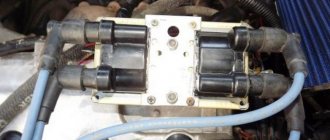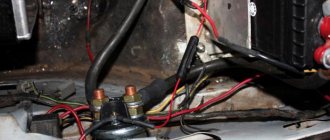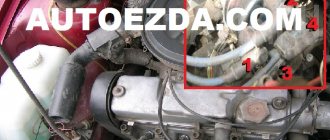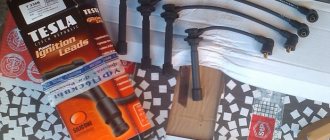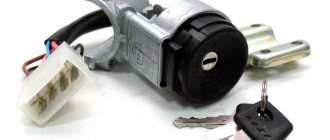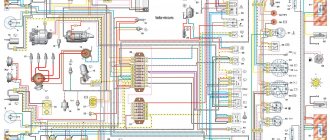Recommendations for connecting high-voltage wires.
The first step is to check the high-voltage wires for resistance using a multimeter tester.
Resistance should not exceed 20 KoM. When you install the wires, do not be lazy to lay them out correctly, without kinks, so that they do not come into contact with other parts of the motor. This will increase their service life. Lay the wire correctly and secure it. The first cylinder in front-wheel drive cars VAZ 2108, VAZ 2109, VAZ 2110 is located closer to the timing belt. If you look at the engine from the front, the first cylinder is the leftmost). The cylinders are counted from left to right - 1, 2, 3, 4.
The procedure for connecting high-voltage wires on a VAZ 2108, VAZ 2109, VAZ 21099 with a carburetor engine
The central high-voltage wire comes out of the distributor cover and is directed to the ignition coil.
The outlet of the distributor cover , directed towards the front of the machine , is connected to the first cylinder.
The output of the distributor cover , directed downwards , is connected to the third cylinder.
The rearward outlet of the distributor cap is connected to the fourth cylinder.
The output of the distributor cover, directed upward , is connected to the second cylinder.
Very often, when repairing a VAZ 2109, high-voltage wires are removed from the ignition distributor or spark plugs. The only problem is that few people remember how they were connected before. To avoid confusion, you need to know the sequence of connecting the high-voltage wires of the VAZ 2109, first to the ignition distributor, and then to the spark plugs of each cylinder.
Connecting wires to the ignition distributor of a VAZ 2109
The ignition distributor cover is placed on it only in one position; it cannot be put on in another way. The distributor cap has a mark; this mark indicates the socket of the high-voltage wire of the first cylinder of the VAZ 2109 engine. The sequence of operation of the cylinders of the VAZ 2109 engine is as follows: 1-3-4-2. The ignition distributor slider rotates counterclockwise when viewed from the cover. Therefore, the lower socket corresponds to the high voltage wire of cylinder No. 3. The next socket, going counterclockwise, corresponds to cylinder #4, and the top socket corresponds to cylinder #2. All this is depicted in the picture below. The numbering of the VAZ 2109 engine cylinders starts from the timing belt and goes from left to right.
Features of the ignition module
Now let's talk about a more complex issue - the ignition module and its design features.
The design includes several components, each of which has its own nuances.
| Component | Peculiarities |
| Ignition coil | There are always two coils on a VAZ 2109. This mechanism is responsible for generating current |
| High voltage switches | Switch keys also work together. Through them, the current goes to the spark plugs, plus the controller regulates the time the current is turned on, which is calculated by receiving information from the crankshaft sensor |
| Electronic control unit | Responsible for distributing information in the form of electronic impulses |
| Frame | High-strength plastic is used for its manufacture, which largely ensures the durability and reliability of the device. |
Ignition coil
Location
Any work related to repair, testing, and maintenance of the ignition module will be impossible to perform if you do not know basic things - the location of the device.
You can find the ignition module (ignition module) in the engine compartment. Find the high voltage wires that go to the spark plugs. One end is connected to them, and the other goes to the module. The MZ is small in size and enclosed in a plastic housing.
Device location
Principle of operation
Initially, on carburetor cars, the system worked due to the presence of an ignition coil. With injectors everything is somewhat different.
- Initially, the ignition coil is turned on, generating a high voltage current. The coil operates on the principle of magnetic induction;
- Then the electronic control unit MZ is connected to the work, performing the functions of control, transmitting commands, and ensuring the flow of current required by the characteristics to the spark plugs;
- Next, the spark plugs activate the spark, ignition occurs, and so on.
MH malfunctions
The ignition module often shows the most basic sign of failure - lack of spark. But this is not the only indicator of a malfunction. These also include:
- Lack of dynamics when accelerating the car. Trying to quickly pick up speed, you can clearly feel failures in engine operation;
- The engine does not produce the usual power; in some cases, the engine is not able to pull the car uphill;
- The idle speed fluctuates;
- One of the pairs of engine cylinders refuses to work. Here, most likely, there is no current that should come from the ignition coil.
To eliminate problems with the MH, the first thing you need to do is check the spark plugs, and then make sure the other elements are working.
Disconnect and check
Checking the spark plugs
To check the condition of the spark plugs, which may cause the module to malfunction, you need to:
- Unscrew the spark plugs from their seats, having first removed the high-voltage wires. The elements are removed with a special key.
- Inspect the spark plugs for carbon deposits, mechanical defects, and poor clearance.
- Send defective spark plugs to a landfill and install new ones in their place.
If replacing or cleaning the spark plugs does not produce results, then the reason lies in other elements of the ignition module.
The principle of operation of a four-stroke power plant
You can understand why it is important to connect high-voltage wires correctly if you study the principle of operation of the power plant. The carburetor or injector of the VAZ-2109 operates on approximately the same principle, since both power plants are four-stroke.
- First, the cylinder volume is filled with the fuel mixture and exhaust gases. This process is called "inlet".
- The engine then goes into compression. With it, the valves are closed, and the crankshaft and connecting rod move the piston upward. The mixture of fuel and air is transferred to the combustion chamber.
- During the expansion stage, the ignition is switched on and a spark appears. It ignites the fuel mixture, resulting in the formation of gases. They put pressure on the piston, causing it to move down. This force is transmitted through the connecting rod to the crankshaft.
- The process is completed by the “release” of exhaust gases through the exhaust system.
In order for the engine to operate smoothly and without jerking, the processes must take place in a certain order. This, first of all, concerns the order in which the cylinders are put into operation.
Checking the cover
Before checking the cap, de-energize the electrical system of the machine by removing the battery terminals, then:
- Using a screwdriver, unscrew the screws securing the cover
- Now you can remove the cover from the ignition distributor
- You can disconnect the armor wires so as not to interfere
- Press the carbon electrode located in the cover with a screwdriver, check its mobility and visually assess its external condition
We check the mobility and external condition of the carbon electrode
- Excessive wear of this electrode or damage to it is not acceptable; if any, the cap must be replaced
- Wash the surfaces (external and internal) of the distributor cap with White Spirit
- We clean all contacts of the side electrodes from carbon deposits with a file; fine-grained sandpaper is also suitable, but not advisable, why - already described above
- The presence of cracks or burns in the lid body is not allowed, only replacement and no gluing
- If any irreparable defects are detected, disconnect the high-voltage armor wires and replace the old cap with a new one
- It is recommended not to save money by buying a new one; the price will be paid off by long-term operation
To avoid mistakes when buying a new spare part, take the old one with you as a sample, because it is light and not too big
It seems like that’s it, we’ve sorted out all the points and examined the part from all angles, now you can remove and put on the cover even with your eyes closed. Our video will further clarify unclear points.
Incorrectly adjusted ignition timing can cause various malfunctions. Most often, problems arise with starting, idling speed and other malfunctions in the operation of the power unit. On the VAZ-2109, it is necessary to set the ignition order depending on the engine type. The adjustment methods differ somewhat depending on the presence of a carburetor or injector in the system, since the ignition circuit changes depending on the type of power plant.
Engine workflow through cylinders
The cylinders are activated as follows:
- In the first there is an upward movement. The gases expand and the mixture of air and fuel burns.
- In the third, to carry out the compression procedure, the piston rises.
- In the fourth, “injection” occurs - the piston moves down and at the same time a mixture of air and gasoline enters the cylinder.
- In the second cylinder, the piston rises and takes the upper position so that gases escape through the valve system. After which the exhaust gases are removed from the power unit.
Setting up a VAZ-2109 with a carburetor engine
First, prepare the car for this work:
- Start the engine, warm it up to 90 degrees and, under the control of the tachometer, bring the number of revolutions of the power plant to 800.
- Remove the tube through which the vacuum occurs from the fitting. Pinch the end of this tube with your finger and raise the speed until the vacuum disappears.
- At this point, turn off the motor and bend the tube so that there is no gap. Loosen the distributor cap. Remove the plug and clean the inspection hatch with the scale located on the gearbox housing.
Next you will need to set the ignition angle. This work is done according to the instructions:
- using a screwdriver, turn the flywheel so that a long division appears in the window (cylinders 1 and 4 will be in the TDC position at this time);
- check how correctly the flywheel is aligned with the timing gear - to do this, remove the casing from the mechanism;
- if everything is done correctly, the mark on the gear will coincide with the one on the belt.
Confirm the adjustment result using a strobe light. For this:
- the ignition coil is connected to the red strobe probe;
- a black probe is installed on the body;
- The fastening wire is fixed to the 4th cylinder.
Now all the preparatory activities are completed, you can start setting up the ignition:
- Start the engine and bring it to 800 rpm.
- Use a strobe to illuminate the viewing window.
- Make adjustments to the angle by counting the distance from the center point. This must be done in accordance with the type of gasoline you use.
- Turn the distributor body to the right - this way you will not make a mistake. If you do this in the opposite direction, the angle will decrease.
The distributor has a special scale marked “±”, with its help you will definitely not make a mistake when setting up. As soon as the required position is set, fix the cover of the ignition distribution mechanism.
How to connect wires correctly
When replacing high-voltage conductors, they are first connected to the ignition distributor. The distributor cover is convenient in that it is always installed in one position. There is a special mark on it, thanks to which it will not be difficult to place the part in place. Before connecting the wires, inspect the cover. It must be intact, since if cracks appear, the performance of this unit is not guaranteed.
The mark on the distributor cover is located next to the wire socket of the first cylinder. The firing order of the cylinders is slightly out of order (1-3-4-2) due to the ignition slider. It moves around the circle (distributor) counterclockwise. It is precisely by this principle of movement of the slider that it is easy to remember the order of the wires. They need to be connected to carburetor and injection VAZ-2109 according to the same principle. On the distributor cover, connect the wires according to the principle of movement of the slider, this is the only way you can set the ignition correctly:
- the socket of the first cylinder is located at the mark;
- the third one is connected at the very bottom;
- on the same line with the socket of the first, there is a place for the wire to the 4th cylinder;
- at the top point the second cylinder is connected.
On the engine itself, the cylinder numbering goes from the location of the timing belt to the starter, that is, from left to right. The fourth cylinder is closest to the starter, and the first is closest to the timing belt. When connecting, it is important to look at which socket of the distributor cover the wire comes from, if you confuse their location, the car will not start.
If you have connected the wires correctly, but the car still does not start, then the problem may be in them. Check high-voltage conductors for integrity. If you haven't changed them in a while, it's worth buying a new set. The peculiarity of these wires is that over time microcracks can form on their surface. They lead to a lack of spark when the ignition distribution system is working. Moisture and dust get into these cracks, which damages the wire from the inside, although it appears intact from the outside.
Purpose of the distributor cover
The design of the ignition distributor cap (aka distributor) has remained and remains virtually unchanged throughout the entire history of the use of this device as part of the ignition system of gasoline engines:
- On most ignition caps, the contacts for the spark plug wires are marked with numbers that correspond to the serial numbers of the corresponding cylinders
- In addition to protecting the distributor mechanism itself from moisture and dirt, it also serves the purpose of alternating the supply of high-voltage current from the ignition coil winding through high-voltage wires to the spark plugs
- It is because of this narrow specialization that the distributor cap has undergone almost minimal changes along the evolution of all car systems
Let's look at the design and operating principle of this much-needed part.
The distributor cap is a molded part made of non-electrically conductive material (insulator) that has the following device:
- Metal contacts are pressed into this part - these are the side and central electrodes
- The number of side electrodes strictly corresponds to the number of engine spark plugs (but not cylinders, do not forget that there are engines in which there is more than one spark plug for each individual cylinder); the distributor cover on the VAZ 2109 in our case has four side electrodes
- A high-voltage (armor) wire coming from the ignition coil is connected to the central electrode from the outside
- To the side electrodes - high-voltage (armor) wires going to the spark plugs
- Inside the cover itself there is a central contact equipped with a terminal that has a spring-loaded contact element (“carbon”), which transmits voltage to the central (main) contact of the distributor rotor (ignition distributor)
Schematic design of the lid
- When installing the cover on the distributor body, it is important to take into account not only the order in which the armored wires are connected, but also the orientation of the cover in relation to the “nose” of the runner is also important
- The ignition distributor cap is attached to the distributor body using latches or screws (the distributor cap on the VAZ 2109 is secured with screws)
- To prevent the formation of condensation under the lid, it has a special ventilation hole
Features of device operation
The “sore spot” of the distributor cover and rotor (ignition distributor) are the electrodes pressed into it:
- The reason is simple - there is no direct contact between these electrodes and the central electrode on the slider, so a spark jumps when they approach through the air, which causes the side electrodes to char rather quickly
- In order for the distributor cap to function reliably, it must be kept clean both outside and inside.
- It is necessary to periodically check the condition of the electrodes contained in it.
- If carbon deposits or oxides appear on them, clean the contacts of the VAZ 2109 distributor cover with a flat file
- It is not recommended to use sandpaper due to the high probability of abrasive particles getting into the distributor mechanism
- In addition, you should carefully monitor the external condition and mobility of the central contact (“coal”) of the cap electrode
Distributor cap as an anti-theft device
Due to the increasing number of car thefts, some “savvy” owners began to use the distributor cap as an additional anti-theft device:
- By removing the cover, which can be removed quite easily, you will make it more difficult for a thief who wants to steal your car.
- Firstly, the car simply won’t start without it.
- Secondly, even if he finds or has a cap with him, having removed the armored wires, you did not mark their connection order, connecting at random it is difficult to quickly achieve correct operation of the ignition
WHICH GDP IS BETTER TO CHOOSE?
When choosing a GDP, two key factors must be taken into account - their resistance and breakdown voltage. The lower the resistance, the better the electrical impulse will be transmitted, and the magnitude of the maximum breakdown voltage determines how resistant the high-voltage wires on the VAZ 2114 will be to breakdowns.
The resistance value of products from different manufacturers differs from each other. As an example, we give you the resistance of the most popular types of GDP:
| Manufacturer | Resistance on cylinder No. 1 (kOhm) | Resistance on cylinder No. 2 | Resistance on cylinder No. 3 | Resistance on cylinder No. 4 | Breakdown voltage (kV) |
| Tesla | 3.27 | 4.16 | 5.02 | 6.26 | 50 |
| Cezar | 3.1 | 3.53 | 4.23 | 5.34 | 50 |
| Finwhale | 1.95 | 2.18 | 2.6 | 3.42 | 50 |
| Ween | 6.17 | 6.57 | 7.52 | 9.89 | 35 |
| Slon | 4.24 | 4.74 | 5.19 | 7.6 | 50 |
The products of the Czech company Tesla receive the largest number of positive reviews from the owners of the fourteenth. Their wires have optimal resistance and high breakdown voltage, and at the same time they are truly made to last - they do not tan or crack.
The cost of the Tesla GDP set is about 500 rubles, Cezar – 450 rubles, Ween – 270 rubles, Finwhale – 600 rubles, Slon – 500 rubles.
Sereshka 05.12.2010 - 18:01
Kiel Blinton (05.12.2010 - 17:56)
:
Good day everyone! Forgive me if the topic is button accordion, but there is no one else to ask. Question - I have an engine 2110 engineer, I bought high-voltage wires and foolishly removed the old ones, but I didn’t remember the connection sequence. If I am facing the car, then the numbering of the spark plugs is 1 2 3 4. But how are they all connected to the square ignition module? If anyone knows, please explain or draw a diagram, please.
There should be numbers on the module itself.
Symptoms indicating a malfunction
Among the main and frequent breakdowns, several can be identified:
- So, the slider may burn out, and this may cause problems with starting the engine. The engine may start, but will immediately stall.
- If the fastening of the distributor is loosened, the OZ could be damaged. This can lead to difficulty starting, loss of power, and unstable engine idling. This is also one of the reasons for increased fuel consumption. To fix it, tighten the fastening with a 10 mm wrench - rotate two nuts, as well as one bolt.
- Another popular cause of malfunction is the distributor wires (VAZ-2109). They may be connected incorrectly or the order may be out of order. The engine may not start at all, or it will start, but at the same time it will “sneeze”.
- Oxidation or destruction of contacts in the cover is a common problem that occurs with ignition distributors for VAZ. If the contacts are oxidized, you can try to restore them with white spirit. This is one of the reasons why the engine troits.
- In addition, the distributor cover may be broken. VAZ-2109 quite often worries its owner about this. You can see the breakdown location very easily. It is clearly visible. A failed cover can cause current leaks, causing various interruptions in the operation of the motor.
- Another problem with the lid is the contact carbon in the lid breaking or wearing off. In this case, the engine will not start. To eliminate the cause, replace the coal separately or the entire lid. If the Hall sensor is malfunctioning, the engine will not be able to start. If the wires from the sensor are broken, the result will be the same.
If the vacuum corrector is faulty, the power unit will not pull up. The power and throttle response of the engine will decrease. The vacuum regulator sets the angle under load a little earlier. One of the possible reasons is a lack of tightness in the regulator body or a leak in the hose from the carburetor. Or the rotary plate of the corrector may be stuck. You can try to fix the leak. But often a complete replacement of the distributor on a VAZ-2109 is required. The asking price is up to five hundred rubles.
It is not difficult to determine that a VAZ-2109 distributor with a carburetor is broken. The car will jerk when driving. However, there are no other reasons for this behavior. If the tank is filled with high-quality gasoline, the fuel pump and carburetor are working properly, then the distributor is to blame for the vibrations. When the car picks up speed, the engine will rev.
Malfunctions can also be judged by an engine that refuses to start. When you press the accelerator pedal and increase speed, detonation occurs. This also indicates a non-working distributor. If the dynamics have deteriorated significantly, then the distributor should be checked. When the fuel rises, the first thing you need to do is find out if the breaker is working, and only then turn the carburetor.
Kiel Blinton 05.12.2010 - 17:56
Good day everyone! Forgive me if the topic is button accordion, but there is no one else to ask. Question - I have an engine 2110 engineer, I bought high-voltage wires and foolishly removed the old ones, but I didn’t remember the connection sequence. If I am facing the car, then the numbering of the candles is 1 2 3 4? But how do they all connect to the square ignition module? If anyone knows, please explain or draw a diagram, please.
Attached images
Post edited by Kiel Blinton: 12/05/2010 - 18:03
Typical electrical wiring faults
Malfunctions, as a rule, boil down to the fact that electric current either does not flow to the spark plug at all, or if it does, it is in limited quantities. And this happens for the following reasons:
- When the current-carrying conductor through which the impulse passes breaks
- If there is a current leak, this means that the insulation is damaged, there is a breakdown of current on the side
- The resistance value exceeds the permissible value
- There are problems with the contacts (either with the spark plug, or with the distributor and ignition coil).
If a current-carrying wire breaks, then an internal spark occurs, in other words, a spark discharge is formed between the ends of the broken wire, which greatly reduces the voltage and also causes a parasitic electromagnetic pulse to occur. So:
- The resulting impulse, of course, negatively affects the correct operation of the vehicle’s electrical sensors
- Just one such defective high-voltage electrical wire often causes vibration and interruptions in the operation of the motor.
- In addition, a damaged high-voltage electrical wire leads to ignition in the cylinder with some delay or even every other time, then the synchronization of the operation of the cylinders and the engine as a whole is disrupted
Checking electrical wires
Anyone can check the wires, and do it with their own hands; this does not require electrical knowledge, or special hard-to-find tools or assistants, only the knowledge of what to do and in what order:
- First, you need to check the spark plug wires on the VAZ 21093 visually for visible damage (for example, cracks, kinks, etc.).
- Then you should make sure that there is no breakdown, this can be done even in the absence of any measuring instruments, it will be enough to look under the hood, with the engine running, when it gets dark, if there is a breakdown, then a spark will be visible while the engine is running on the broken electrical wire
- You can also check high-voltage electrical wires using a wire; you just need to take a piece of wire at night and strip the ends on both sides. Then you need to close one end of the wires to ground (this is the body of the machine), and take the other end with your hands and move along the entire length of each electrical wire, not missing joints and caps, etc. A spark will occur at the breakdown points
You can also measure the resistance of high-voltage electrical wires; for this we need a tester (multimeter):
- Turn on ohmmeter mode
- We remove the wire from the spark plug of the first cylinder, disconnect it from the distributor (see The device of the VAZ 2109 distributor: the difference between contact and non-contact ignition systems and adjusting the ignition timing)
- We connect the multimeter electrodes to both ends of the wire and check the readings
For serviceable electrical wires, the resistance varies from 3.5 to 10 kiloohms, it all depends on the type of electrical wires themselves. The resistance value is usually indicated on the insulation of armored electrical wires. When checking each wire, the spread between the values cannot exceed 2-4 kiloohms. If greater variation is detected, the wires should be replaced. By the way, the replacement is made as a set, that is, all together at once; the price here is not a reason to save money all together. In conclusion, we present to your attention the resistance readings for the most popular armored electrical wires:
- Tesla brands have a resistance of 6 kOhm
- Brands Slon (Elephant) with a range from 4 kiloOhm to 7 kiloOhm (where 4 kiloOhm goes to the 1st cylinder and so on up to 7 kiloOhm on the last cylinder)
- ProSport brands have almost zero resistance
- Brands Cargen (Kargen) with a resistance of 0.9 kiloOhm


